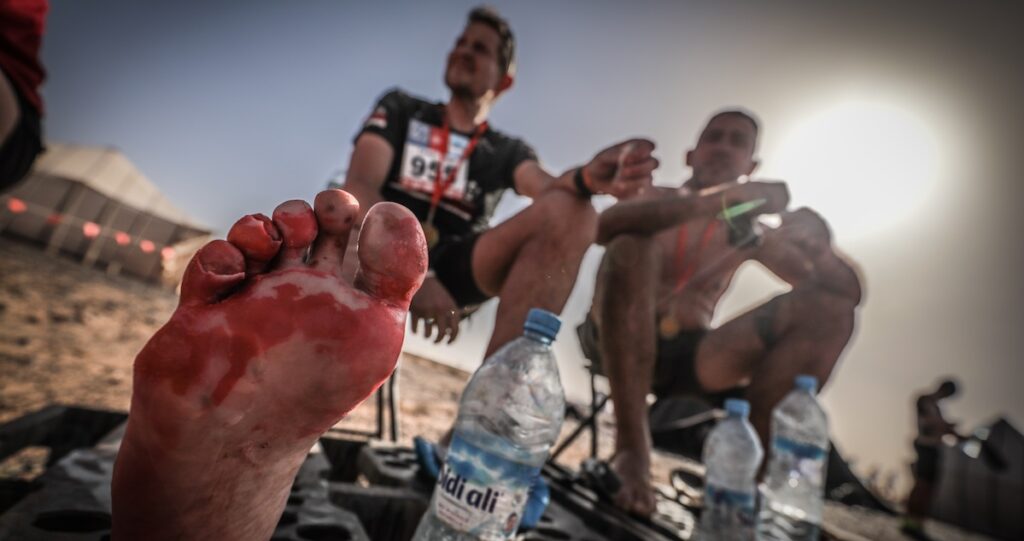I was red faced and sweating profusely at the gym when my phone started to buzz with text messages and Facebook notifications.
Normally, I ignore my phone whilst deep into my Bulgarian split squat routine. But this wasn’t just a text from the wife asking me to pick up some milk on the way home, or someone liking my artistic shot of some cows on my morning run-commute.
At the top of the list of notifications was a WhatsApp message from none other than Dean Read himself, the Spine race’s event manager. It read, ‘check your emails, you’re in!’
My heart sank ever so slightly because this could only mean one thing… my name had been drawn in the Spine volunteer lottery!
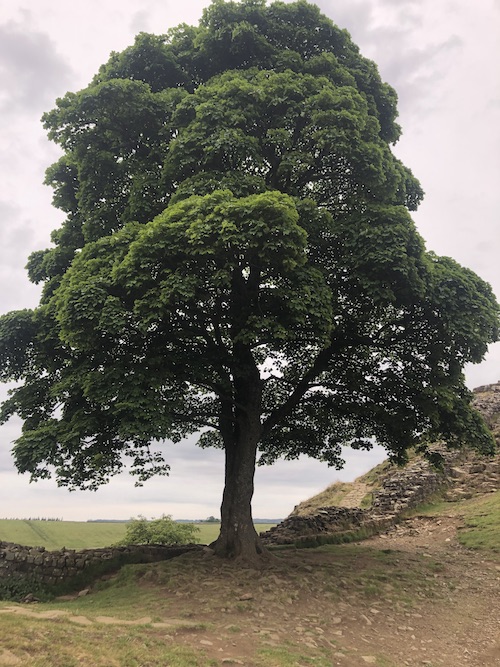
Image: Sam Hill
The Spine Family
As a member of the ‘Spine Family’, the term used to describe the close knit community of race volunteers. I knew that like everyone who puts their name into the lottery, the chances of having your name drawn are slim. But there’s always the chance it does, and I was now in the unenviable position of having my name on the start list of one of the most infamous races on the planet.
The Spine race is well known as ‘Britain’s most brutal’… and for obvious reasons.
Run in January in the middle of the UK’s bleakest winter month. In most people’s opinion THE worst possible time to put on a 268 mile romp up Britain’s toughest national trail. It’s easy to see why this race attracts brave souls from all around the world.
To complete the Spine in the niche of a niche sport of ultrarunning is akin to being part of a World Cup football team. To win it, or podium at it, is like actually winning the World Cup itself!
But with the race now into its 10th year, the organisers have been busy behind the scenes chopping and serving up the iconic event into more ‘doable’ chunks.
This makes sense not only from a business point of view, but also for anyone brave enough to want to do the iconic race. It can seem less daunting to do smaller versions in the lead up to completing the full event.
But obviously that view is subjective and depends on what you believe to be ‘doable’ about a route that is famous for its iconic views and sometimes eye wateringly tough terrain and remote locations.
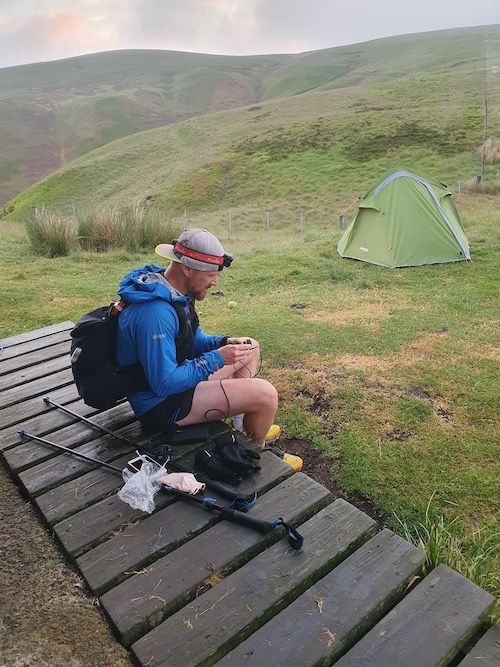
Image: Nige Burke
Top Fan
Having been a big fan of the race for many years, first helping out on one of the many checkpoint teams and then blagging my way onto the media team this past winter, (thanks Will) I have long dreamt of one day doing the race for myself.
Like most people approaching such an epic journey, I’d decided to take the sensible route of completing the smaller ‘doable’ races making up the full distance. I started this journey with the inaugural Summer Sprint race held in 2021. 46 miles of the iconic route from Edale to Hebden Bridge.
Despite messing up my hydration and vomiting from mile 31-46, I believe the race to have been a great success!
My next goal was to complete the Challenger South race. However, injury reared its ugly head and scuppered my plans. Hence being red faced and sweaty in the gym when the opportunity came up.
So as I read the messages of congratulations and commiserations it dawned on me, I had a place in the full winter Spine Race 2024!
Don’t Panic
But at this point I hadn’t ran more than a 40 mile week for around a year.
I’ll spare you the long story of woe surrounding my knee issues. But the short version is that I had less than 10 months to do 2 very important things. Firstly I had to get my knee in good enough shape to even be able to run consistently for the next 10 months of preparation. Secondly and by no means to a lesser degree, I had to figure out if I could even run 100 miles, let alone 268 along the Pennine Way!
Because up until this point in my ultrarunning career, I’d only ever ran as far as 100km. Well ok, there was that time I got lost at the end of the Ranger Ultras High Peak 100k. When both of my headtorches decided to die on me and I ended up running 70 miles in total, but that was incidental.
During my Ultra career I’d become a 50k and 50 mile specialist, winning a handful of local races and even claiming a few course records along the way.
I was confident in my running ability, but having never even ran a 100 mile race, I wasn’t sure I’d even get part way up the iconic Spine Race course. I needed a plan and I needed it quick!
So I put on my ultrarunning coach hat and sat down to see how I could logically make all of this work.
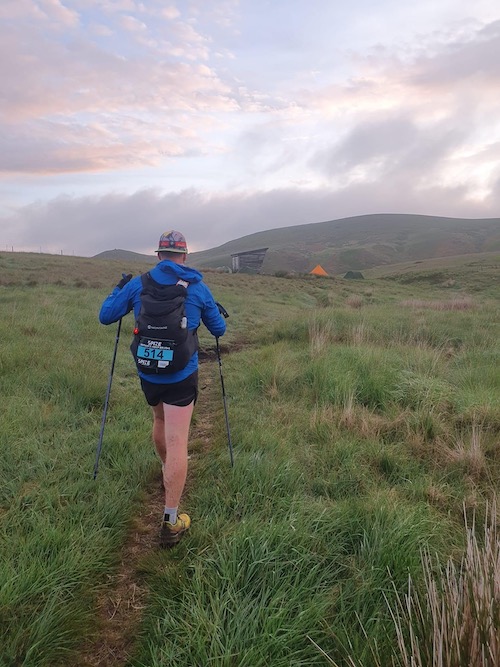
Training
The knee issue I knew would be something that could throw a spanner in the works, but since concentrating on low mileage and hitting the gym 3 times a week it was starting to feel better.
So I had to take a gamble. Keep working on the knee and upping my mileage but with the secondary goal in mind……going long!
In hindsight I’m still not sure of my reasoning, but it went like this: If I could get strong enough to put in a decent training block through the spring, I’d enter a big race of at least 100 miles in the summer to see if I had what it takes to go the distance needed for the Winter Spine.
So that led me to an anxious decision. It was the last day to enter the remaining summer Spine races for 2023. Do I opt for the Challenger South, the 108 mile ‘doable’ race? Or do I go all in and hit the red button for Challenger North, the 160 mile epic covering the top half of the course? Which would hurt my knee most? Either? Or both?
So, as with most things in life I obviously went all in and clicked enter on the North race. If I was going to get Spine Race experience, I may as well get as much as possible!
I managed a build up which culminated in a couple of weeks peaking at 70+ miles, which I was happy about (even though this used to be my regular commuting mileage pre-injury) and this gave me the confidence that I could at least attempt the task set before me.
Race day
Arriving in Hardraw at the start of the race, I noticed that I didn’t have the usual pre-race anxiety that I normally have. I think this is mainly down to the fact that I viewed this race as more of a giant supported recce for the big race in January, rather than a race that I wanted to do with any ideas of competition or a time in mind. The goal was to just get to the end alive!
As the start time approached the sky started to look ominously dark. Sure enough as clockwork, just before the 6pm start time, the heavens opened up! Everyone scrambled to get out their waterproofs in time for race director Phil Hayday-Brown to give the starters orders.
Off we went into the inky atmosphere, in the strange scenario of being fully togged up in winter gear, for a warm summer race. Within minutes, everyone powering up the long climb to the summit of Great Shunner fell was complaining of being too hot. I exclaimed to a fellow runner that I felt like a jacket potato cooking in tin foil.
People stopped to change gear and remove layers and we trundled on up the climb with the top of the fell now obscured by cloud and lightning making the odd appearance.
When if recced this part during a hot, clear sticky day the views were spectacular. But now all that could be seen was a looming mist and grey shapes in the distance.
A small group of us dropped down the back side of the Shunner. I felt a sense of relief as we had made it through the first big climb of the race without being struck by lightning! Small mercies it would seem with what lay ahead of us.
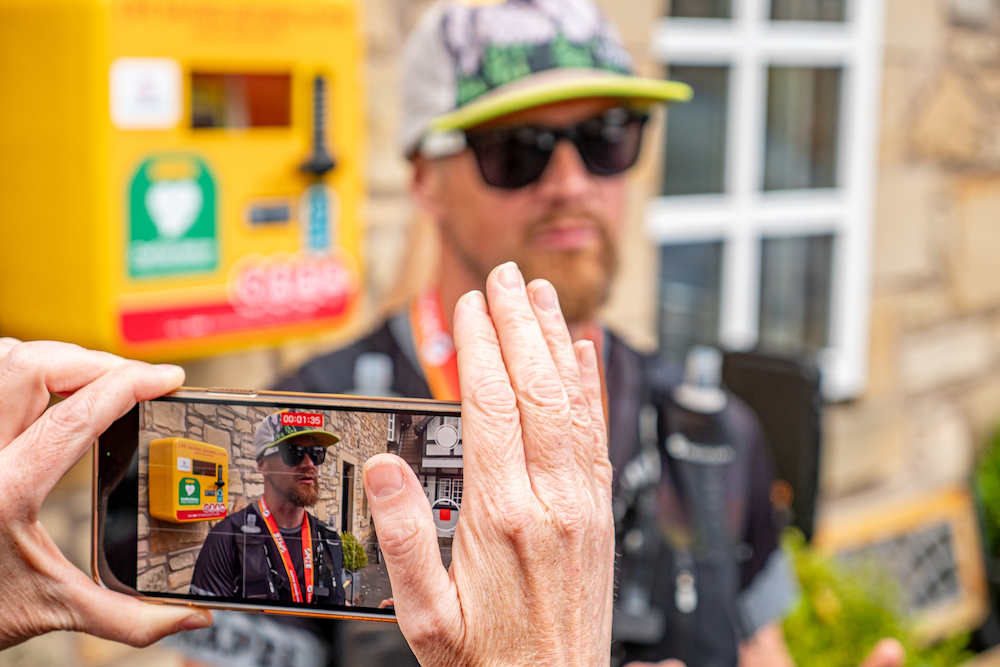
Image: Nicky Lygo
Britain’s Highest Pub
The rain continued to soak us through as we picked our way up to the famous Tan Hill Pub, the highest pub in Great Britain at 1732 ft above sea level. The side room used for the race safety team checkpoint was warm and dry and a hit of coffee with 2 sugars went down a treat as I stopped to change some layers and socks.
During this section it was good to spent some time running with Ellie Eccles, the GB ultra runner who was targeting this race to earn herself a spot on the upcoming 24 hour championships. We talked about running schedules and having a young family. We got lost a couple of times/stopped while the other person peed and shared some snacks. The usual things that bond you in an ultra.
The rain continued to pour through the night as we marched on to the first official checkpoint at Middleton in Teesdale.
In the winter this checkpoint is up in the village but for the summer edition, it’s a campsite at Low Way Farm that dishes out the much needed food and shelter.
It was great to see old friends Hannah Rickman and Jen O’Neil’s smiling faces as they dished out food, drinks and cheekily asked for an interview from me, clearly mocking me for my job on the media team earlier in the year. Ok I’ll take that as it was done with big smiles on their faces!
Cauldron Snout
Next up was High Force and eventually Cauldron Snout waterfall. All were stunning but the latter was particularly impressive because the trail just seems to disappear when you get to the falls. The trail does continue, but it’s a literal scramble up the side on wet slimy rocks.
It was broad daylight, in summer. My mind immediately went to the possibility of getting to this point in the winter race in the middle of the night, in rain, or snow or gale force winds! But for now it was daylight and it was summer so it all went without hiccup.
The next section felt a bit laborious and nondescript until reaching High Cup Nick. If you’ve not seen this before, it’s worth a hike to see! It looks like a meteorite the size of a mountain has gouged a great chute into the landscape. It really is something special to behold!
After dropping down into Dufton and getting my feet looked at by the medics, next was the climb up onto Great Dun Fell and the infamous Cross Fell.
These climbs were tough, but the views were spectacular nonetheless. Cross fell seemed to come into view and disappeared as soon as it came. Which can’t however be said of the rock strewn road (if you can call it a road) that leads you down to Garigil in the valley. It seemed to go on forever!
The day was now long and had grown stiflingly hot while I’d been at elevation away from the heat.
My feet swore at me, I had ran out of fluids and the trail that led me to the checkpoint at Alston was swarming with horse flies and longer than expected.

Power Napping
I reached the checkpoint at Alston feeling absolutely destroyed and wondered if it was even possible to reach the end of this race.
I decided I needed a reset and I headed straight up to the bunkhouse to take a shower and try to sleep. At this point it was 6pm on Monday and I hadn’t slept since Saturday night. Could I sleep? Too right I could. In fact, if I hadn’t set my alarm for 3 hours (2 full 90 minute sleep cycles) I would probably have slept right through to Tuesday morning!
When I woke I wasn’t sure how I was going to feel. Would 3 hours be enough? How would my feet feel?
Weirdly, I opened my eyes and after a moment to realise where I was, I immediately felt great! Somehow, 3 hours sleep had reset my whole system and I felt ready to roll again.
After another plate of the famous Alston lasagna and a foot patch up by the ever talented medics, I was off into the night. Headtorch on, earbuds in and a podcast on to keep me entertained. I trotted through another night feeling like I could actually do this.
As morning broke I reached Hadrians Wall. This is known for being really up and down and a real leg tester at times. I felt great and I pushed on to catch up to 2nd place lady and share a few miles together.
I still felt good so decided to push on ahead.
The feeling of being in a good place didn’t last unfortunately and I soon found myself wandering slightly off course and hallucinating big black bears in the forest. I knew they weren’t real, but they did seem it at the time. In fact I saw quite a few things over the course of the days that didn’t make sense. Before this race I assumed that any hallucinations would come during the night, but actually all of mine were in the half light of dusk or dawn. I saw an old man with a wheelbarrow. I saw the grim reaper stood guard by the trail and obviously I saw lots of big black bears.
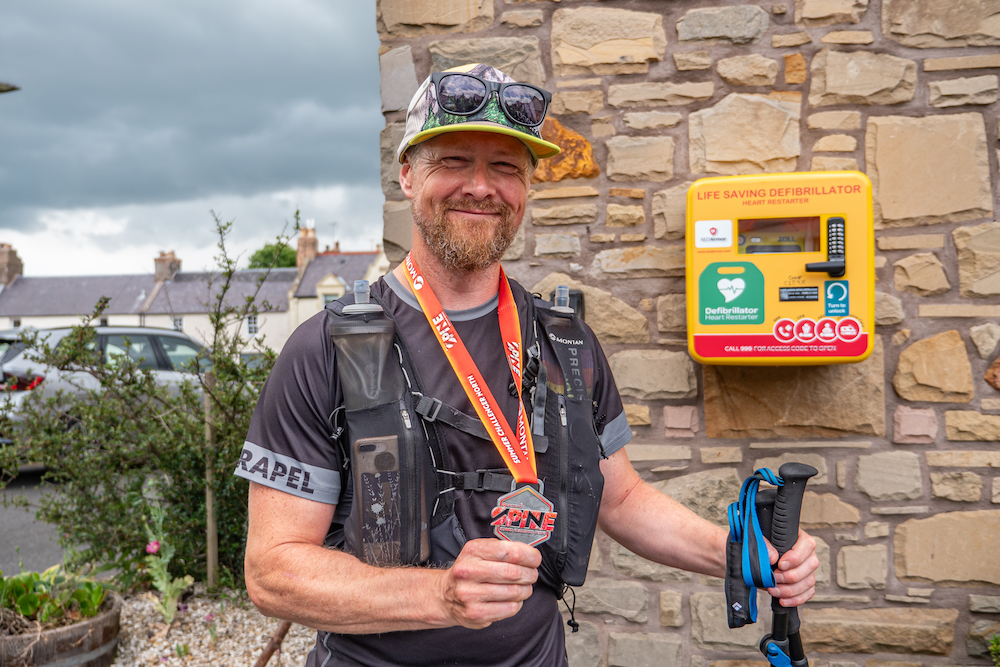
Image: Will Roberts
Getting closer
The next checkpoint was Bellingham and I knew that getting here was a critical part of the race. From here it was just a short jaunt of 40 miles over the Cheviots, easy right?
I tried to sleep at Bellingham but it was in a tent, in the heat of the day and there was nowhere to hide. I gave up after 20 minutes of snoozing and decided I need to put in an effort to get to the finish.
There’s a long climb on the road out of Bellingham so I took the time to phone the family and let them know I was ok. My feet were now a major issue and I was taking pain killers every couple of hours just to take the edge off. Apparently the perfect storm of torrential rain followed by heat was causing every runner issues with their feet. Blisters, macerated feet and the rest were the order of the day and I was suffering.
I’ve had blisters in races before, way back in my early days of ultra-running. I assumed they were a thing of the past. But no no, this was an issue that I wasn’t ignorant to, I’d known that people get mega blisters on this race, but I naively thought I wouldn’t be one of them!
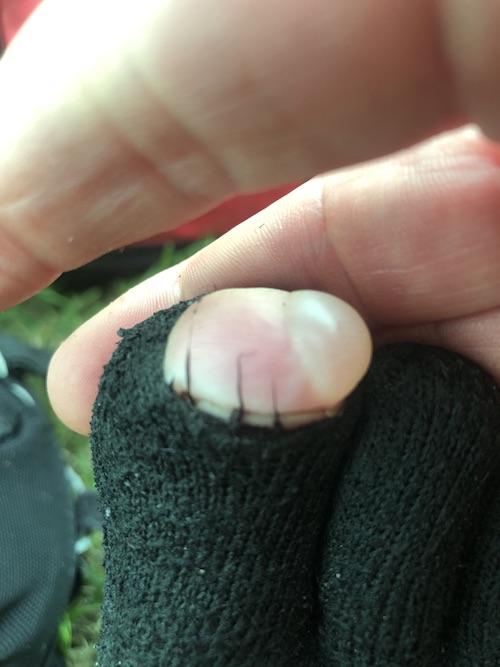
Image: Sam Hill
By the time I’d reached the safety team checkpoint at Byrness I was again in pain with my feet. The medic took a look while the legendary John Bamber made me a coffee with plenty of sugar.
While I was having my feet looked at, I could feel an overwhelming feeling of exhaustion pass over me. I was sat there nodding like a dog when John suggested I bivy at the public toilets just 50 yards down the trail. This seemed like an excellent idea.
Once my feet were taped up I trundled down the trail to try to get at least a 10 minute Power Nap in the loos.
I hadn’t yet used my bivy so I was almost excited to test it out.
So there I stood, with my feet in the bivy and wrapped in my puffer layer ready to pull it up and lay down on my concrete bed. When something dawned on me, the sweet and strong coffee that I’d sipped on during my foot check had now well and truly kicked in! I was wide awake and the thought of sleeping felt like a ridiculous idea. There was no way I was going to even have an on off snooze. It was time to head up onto the Cheviot Hills.
Wild Weather
The winter Spine is known for its wild weather. The summer race one would assume would be much milder. Which it was, but it did throw some weird temperature fluctuations at us.
In the valley at Byrness, I was in my short shorts and a T.
As I powered up the climb to the appropriately named Windy Gyle, I was sweating profusely and although it was around 1am it seemed like it was the full warmth of the daytime.
This feeling was short-lived as I crested the summit and the full force of ‘Windy Gyle’ hit me. I laughed at the irony of the name as I literally put every layer on including my beanie hat to keep my ears warm. I know it was mid June, but it felt more like winter. Again the thought of what it’s like up there in mid January crossed my tired mind.
From this point on it was me against the fog, wind and dozy sheep that used the paving slabs as their beds. Their eyes glowing back at me from the light of my head torch.
By now I felt confident that I would finish, but at the same time my feet felt like they were on fire with every step.
The fog faded and the sun started to rise in the distance.
Hut 1
After finally reaching Hut 1 I felt like the job was almost done. Despite the fact that there were 16 tough miles from Hut 1 to the finish.
After a quick chat with Nige Burke the logistics legend it was time to push on for Hut 2 and the finish.
At this point I had my most iconic moment of the whole race. As I powered up a climb heading into the sunrise I could see what I thought were either Cheviot Goats, or a vivid hallucination. Thankfully they were real and they trotted across the trail in the beautiful half light of dawn. I stopped and appreciated the moment for what it was. A moment in time, a moment of reflection in a crazy few days that felt like a dream/nightmare at times. I’ll never forget that moment and it’s etched into my memory forever.

Image: Sam Hill
The next section of around 10 miles seemed to go on forever. The sleep demons were well and truly on my shoulder by this point. I somehow managed to get off course. Not by much, but enough to make me feel slightly distraught and angry that I’d made such a simple nav error.
I was now feeling the effects of running through multiple nights on no more than 3 and a bit hours sleep.
I was so tired that I scanned the surrounding terrain for somewhere to sleep. Suddenly, even the big fissures in the peat bog seemed appealing enough to crawl into and sleep. But I had just enough wherewithal to know that taking a nap off course would arouse the interest of the safety team and cause needless stress for anyone involved. So I pushed on back to the trail and decided that I would just sit down and take a trail nap right there against the fence.
This worked a treat and I nodded off for a 10 minute Power Nap before being woken by 2nd place lady.
Hut 2
I tried to keep up with her towards hut 2, but by this point my feet felt like lumps of fiery coals that burned with every wincing step.
With hut 2 now in focus the pain in my feet reached a crescendo. I sung to myself out loud to try to focus on anything but the pain. I was so close to the finish with only 6 miles to go, but my feet hurt so much that I needed to get them patched one last time by the medics at Hut 2.
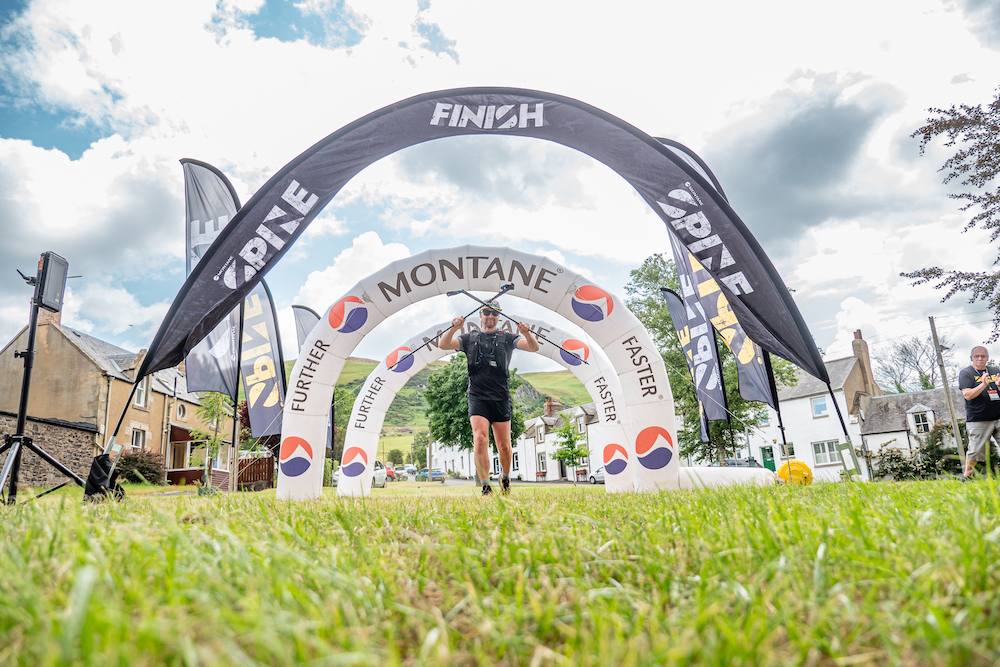
Image: Will Roberts
In any other race I would have gritted my teeth and pushed on for the finish. But 6 miles of the Pennine Way can sometimes feel like 60 miles.
As I descended into the valley with Kirk Yetholm in my sights, the heat of the day set in. By now the morning had turned to midday and the temperature was now rising to blazing heat even for Scotland.
I’d summoned enough enthusiasm to actually run from hut 2, but this quickly faded as I reach the final big climb. Once I’d crested this final top I knew the end was in sight, even if it was only metaphorically.
I trudged along through the heat on the hot tarmac road that leads directly to the finish line. I’d been on this bit of tarmac many times before as part of the race media team. I’d hassled runners to put on a final spurt to the finish. Many of which refused at the time and it had almost annoyed me. But now I understood. This race, wether it’s the sprint, challenger south, challenger north or the full spine is incredibly hard and even a light jog at the end can seem like an impossibility.
And that’s exactly how I in that moment felt. My phone was buzzing with all of my running mates messaging me to speed up because I was right at the end. My good friend Mark was so engrossed with following the tracker that he cancelled all of his work meetings for the day just so he could see me finish. All I could do was hobble and curse my feet!
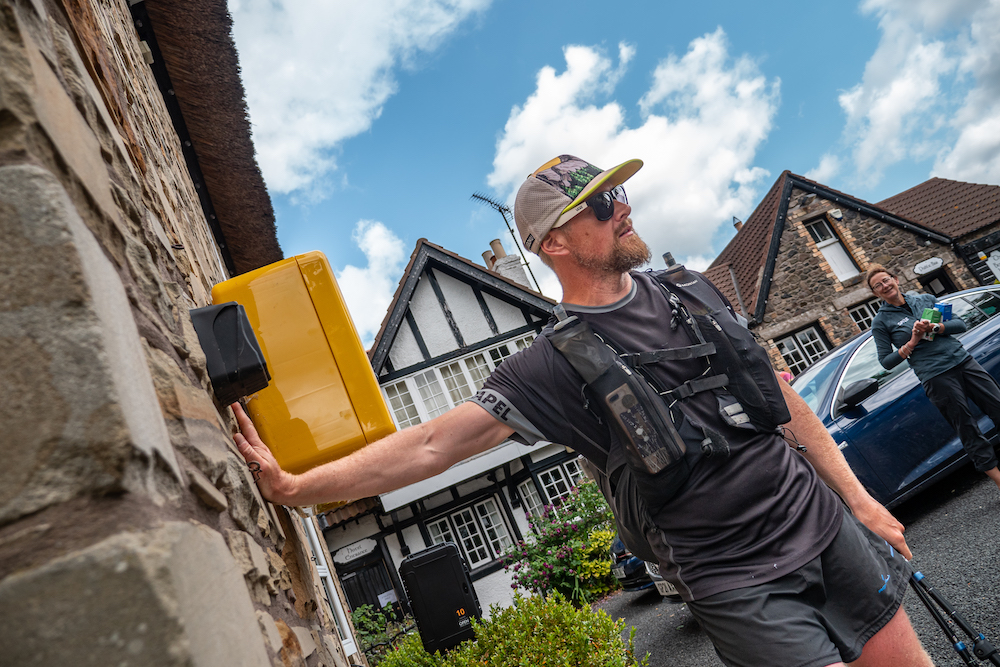
Image: Will Roberts
The End
Going into this race I knew that 160 miles is a long way. I knew it would be hard, after all it is Britain’s most brutal race. But it’s also Britain’s most beautiful race too. I’m glad I did take precious moments to stop and take it all in. I took lots of pictures that either fill me with awe, dread or joy depending on where they were in the race.
As I crossed the line to the applause of checkpoint staff, other runners and my friends on the media team I felt like a job was indeed done. I had run the Spine Challenger North. It was possible, it was ‘doable’, all I needed to do now was recover in time for the big one! The full Winter Spine Race! But you’ll have to wait to hear how that turns out. So check back with me in January and I’ll let you know whether that race is ‘doable’ or not!
Thanks to the Spine Media Team/Will Roberts for the images.
Montane Winter Spine Sprint Race Report
The Montane Summer Spine Challenger Report

